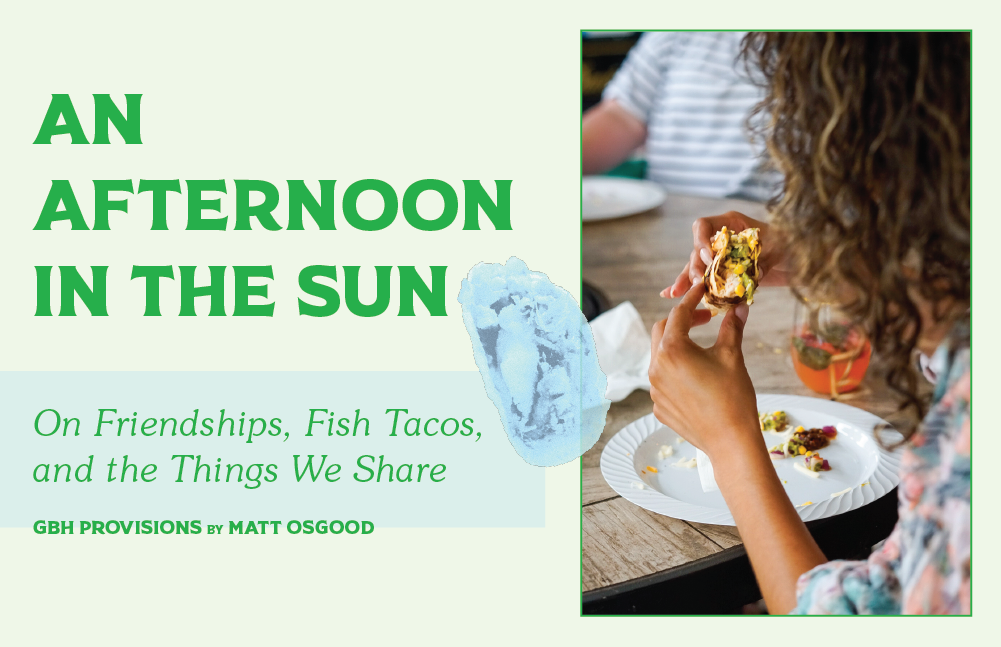As a native East Coaster who relocated to San Diego in 2004, I didn’t know what to make of fish tacos.
Before I arrived on the West Coast, the only tacos I knew were filled with greasy ground beef, artificial seasonings, and a more-than-healthy dose of shredded cheese. Fish in a taco seemed out of place. The fact that my very first fish taco was not eaten along some sunny San Diego shoreline with the Pacific Ocean cresting and crashing in the background—but rather at a chain taco joint in a strip mall miles from the coast—did not help convince me otherwise. The experience was, in a word, unsatisfactory.
My opinion was corrected only later. In the year or so I spent in San Diego, my professional life was divided into two parts: covering high school sports for a local newspaper and painting houses.
“One of my favorite memories from that period in Southern California remains the time my friend and I drove north on the Pacific Coast Highway to find a place for a fish taco and a Corona. Finally, there it was: that cinematic beer and a taco on the California coast.”
In the latter job, most of my coworkers were Mexican—and at lunch, they introduced me to dishes beyond the generic chain restaurants. My first real fish taco was eaten sitting on a ladder outside a one-story, Spanish-style home in the city of La Mesa. The crunch of the batter balanced by the richness of the guacamole and zest of a freshly squeezed lime must have prompted some moan of culinary happiness and tickled my co-workers, who called me, affectionately, “Rubio.”
From that game-changing fish taco, many more followed. One of my favorite memories from that period in Southern California remains the time my friend and I drove north on the Pacific Coast Highway to find a place for a fish taco and a Corona. Finally, there it was: that cinematic beer and a taco on the California coast. Ever since then—even upon becoming an East Coaster once again—I’ve tried to re-create that afternoon in the sun.
This recipe didn’t just begin as an exercise in nostalgia—it was also a way to create something out of the bounty of stripers and sea bass my friends and I caught every summer on Massachusetts’ Cape Cod Bay. Over the years, I’ve attempted big and small batches. I’ve skimped on ingredients. I’ve overcooked the fish and undercooked the tortillas. One dinner, long ago, I asked my wife how the tacos turned out and she replied, “Not your best. Kind of boring.” That statement cut me to my core.
It’s been my mission to nail this recipe ever since. I’ve learned over the years that making these tacos isn’t just about savoring the food, but also about the communal aspect of creating a serving station and letting everyone choose their own culinary adventure. This recipe works on a small scale, but it really succeeds for large groups.
I’ve long said that the key to a great taco is the tortilla. It’s not just a question of finding the correct brand. (Tip: Skip the basic grocery store options and spend extra cash on higher-quality flour tortillas). You’ve also gotta warm them up. You can use the microwave or the oven, but we’ve decided we like our tortillas best with light char from the grill.
“One dinner, long ago, I asked my wife how the tacos turned out and she replied, ‘Not your best. Kind of boring.’ That statement cut me to my core.”
The next step is determining how to cook your fish. Along with family and friends, we’ve tried it all—frying, baking, experimenting with different batters, watching as the fish has fallen right out of those unsuccessful batters. In the end, we landed on breading and frying. The trick here is to take your time: Let your floured fish hang out for a bit. Don’t rush.
The last real component of this recipe development was deciding on the ideal toppings. There’s an instinct—especially among East Coasters—to add cheese to any taco, but we’ve determined it to be unnecessary here. Our taco-making group of loved ones have toyed around with black beans and refried beans. We’ve added corn. We’ve experimented with red and white onions. We’ve tried multiple hot sauces—we want heat, but we don’t want to overwhelm. Once we started making our own salsa, it was game over for store-bought.
In terms of garnishes, the one constant has always been a trio of cilantro, guacamole, and lime. Don’t ever consider these expendable. Every other ingredient has been examined and questioned and analyzed. This recipe here is the one that’s stuck, that gets you the perfect balance of heat, texture, and flavor. It just works.
More than anything else, the development of this recipe was about learning the lesson of patience. It’s not about getting the food out as fast and hot as possible—this isn’t the chain taco place where I had my first fish taco. It’s about taking the time to make sure everything is done right. (I’ve learned, too, that a premade batch of margaritas keeps everyone as patient as possible.)
Friendships are weighed in distance, both in time and miles. Some of our greatest relationships are strengthened by that separation, while others atrophy and fade away. Then there are the newer bonds, built with ease. As we get older, we need both—and today, as my family hosts our latest taco party, we’re surrounded by both.
No matter how long a friend has been in my life, there’s a special bond that comes from serving them food—few things feel more personal than cooking a meal for someone. And who would say no to a fridge full of beers and tequila, and a party by the pool as summer fades to fall?
“The rule is you call the kids first. After they ignore you, invite the adults. The cook eats last, which, to me, seems both polite and self-serving: Nothing is better than watching the people you love eat the food you just prepared.”
If you’d like to add another layer of community, I can recommend assigning tasks to other amateur chefs in your kitchen. As I make these tacos, kids run rampant around the house and compare dives in the backyard pool. My friend Nate grills the tortillas. Our wives huddle around the chips and salsa, laughing over homemade strawberry-basil margaritas. A Tribe Called Quest plays on the speakers.
There is a balance of entertaining and preparation that can only be mastered with practice. We want to be good hosts, but we also know there is food to be prepared (and, today, photos to be taken). Angela Rosario is our photographer, and someone I’ve known since she was in my 9th grade English class more than a decade ago. We all hang in the kitchen while I slice the fish and season the flour. I act the part of a food show host—slicing and chatting, instructing and joking—while the camera clicks. I tell a story about when I was teaching in a majority-Dominican community and heard a student’s quip that “white people don’t season their food.” I promise to buck this criticism, all while dredging the fish in the flour before placing it in the sizzling oil, reminding my hypothetical food show viewers to “lay away” from your body.
The presentation of the entire feast, all laid out for the crowd to enjoy, is the kicker. The rule is you call the kids first. After they ignore you, invite the adults. The cook eats last, which, to me, seems both polite and self-serving: Nothing is better than watching the people you love eat the food you just prepared. The instructions are simple: Serve yourself as much fish as you want, lather on the guacamole, load up on salsa. This recipe is about challenging a crowd to make that perfect fish taco … and then watching them come back in 10 minutes to try to make another that’s even better.
Eating is an act of communion, after all, and the luckiest of us get to do it together. In between telling stories about our collective pasts and presents—digs at my former tweedy fashion choices; shit-talk about friends’ former boyfriends; reminders that us“old people” can still have fun, even while knowing our younger guests will need less recovery time from those margaritas—we’re digging into homemade salsa with the crumbs of tortilla chips and seconds of carefully constructed fish tacos. The pours get more liberal.
We stay up late, letting the kids enjoy the late summer freedom of a deferred bedtime. Everyone leaves happy and full, in both the literal and metaphorical senses. Filled with tacos and pitchers of margaritas, sure—but filled also with the shared experience of time well spent together, a need far too infrequently met.
Serves 8
For the salsa:
5 plum tomatoes
1 head of garlic
1 large white onion, chopped
1 jalapeño, scored and deseeded, chopped
Juice from half a lime
Sea salt, to taste
Red pepper flakes, to taste
For the guacamole:
3-4 ripe avocados
Salt, to taste
Dash of red pepper flakes (optional)
Juice of half a lime
For the fried fish:
2 pounds mahi mahi fillets (or another white fish of your choosing)
1 cup all-purpose flour
Sea salt, to taste
Pepper, to taste
Chili powder, to taste
Vegetable oil for frying
To serve:
2 cans refried black beans, warmed
2 cans sweet corn, strained
1 red onion, chopped
1 white onion, chopped
4 habaneros, cored and sliced (optional, if you like extra spice)
Hot sauce, to taste (we are a Yellow Bird family)
1 bunch cilantro, washed and chopped
About 24 flour tortillas, warmed
1. First, roast the tomatoes and garlic for the salsa. Preheat the oven to 350° Fahrenheit. Cut the tomatoes in half and place, cut-side up, on a foil-lined baking sheet. Season with salt.
2. Next, slice the top off one whole head of garlic (just so the cloves are exposed, but the head is still held together). Drizzle over olive oil and season with salt and pepper before wrapping tightly in foil and placing on the baking sheet.
3. Roast for 45 minutes, or until the tomatoes begin to look darker and drier on the surface. Remove from the oven and leave to cool slightly.
4. To make the salsa, place the roasted tomatoes in a blender or food processor. Add the garlic, carefully unwrapping the foil and squeezing out the softened garlic cloves. Add the onion, jalapeño, and lime juice, as well as a good pinch of salt and red pepper flakes.
5. Blend to your desired consistency. Taste, and adjust the seasoning if needed. Transfer to the refrigerator and allow to chill for at least 1 hour.
6. While the salsa chills, make the guacamole. Peel and smash your avocados in a medium mixing bowl. Mix in the lime juice and season with salt and red pepper flakes, if using, to taste. Set aside. Cover and place in the refrigerator if you plan to serve later.
7. When you’re ready to make your tacos, slice the fish fillets into roughly 2-inch strips with a paring knife. In a large bowl, whisk together the flour, salt, pepper, and chili powder. (If you can’t see the seasoning in the flour mixture, you need more.) Toss the fish in the spiced flour until well-coated.
8. Add vegetable oil to a medium saucepan until it comes roughly 1 inch up the sides. Place over high heat until the oil reaches 350° Fahrenheit. (Use a deep-fat frying thermometer if you have one; if not, you can tell the oil is ready by placing a wooden spoon in the oil—if the oil bubbles around the spoon, you’re good to go.)
9. Cook several pieces of fish for 2-3 minutes, being careful not to crowd the pan, or until golden-brown. Flip and cook for another 2 minutes. Transfer to a plate lined with paper towels and leave to cool slightly. Repeat with the remaining batches.
10. While the fish rests, warm the tortillas in the microwave, on the grill, in a dry frying pan, or under your oven’s broiler. (We choose to grill them, after applying a spritz of cooking spray to each side.)
11. To serve, take a personalized, mix-and-match approach. Start with a base of the tortilla, warm beans, then fish. Add all other ingredients, or the ones you prefer best, to make your perfect fish taco. [Author’s note: My order is beans, fish, guacamole, salsa, red onions, and cilantro, topped with Yellow Bird Habanero Hot Sauce. Wash down with a margarita.]


















